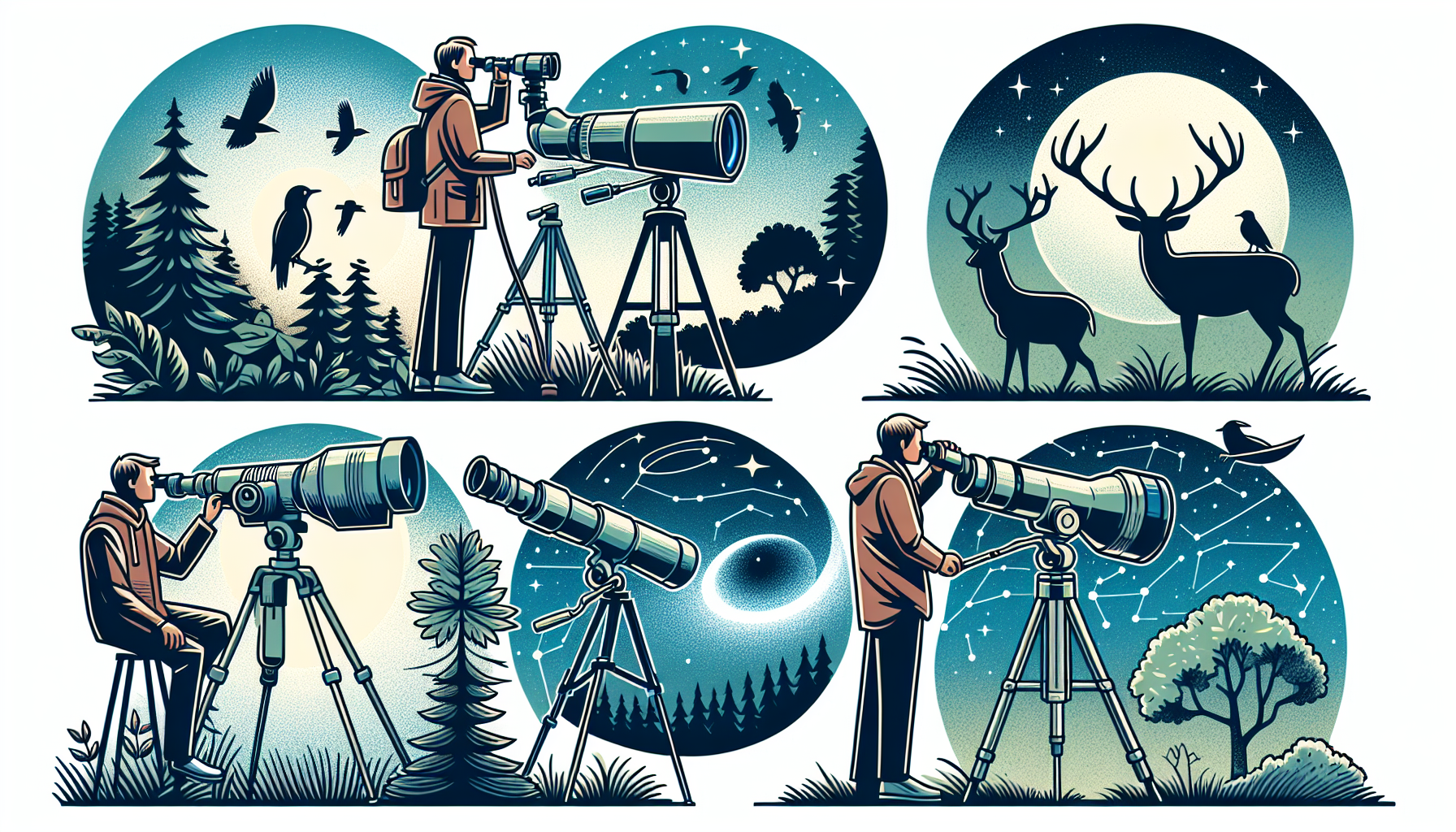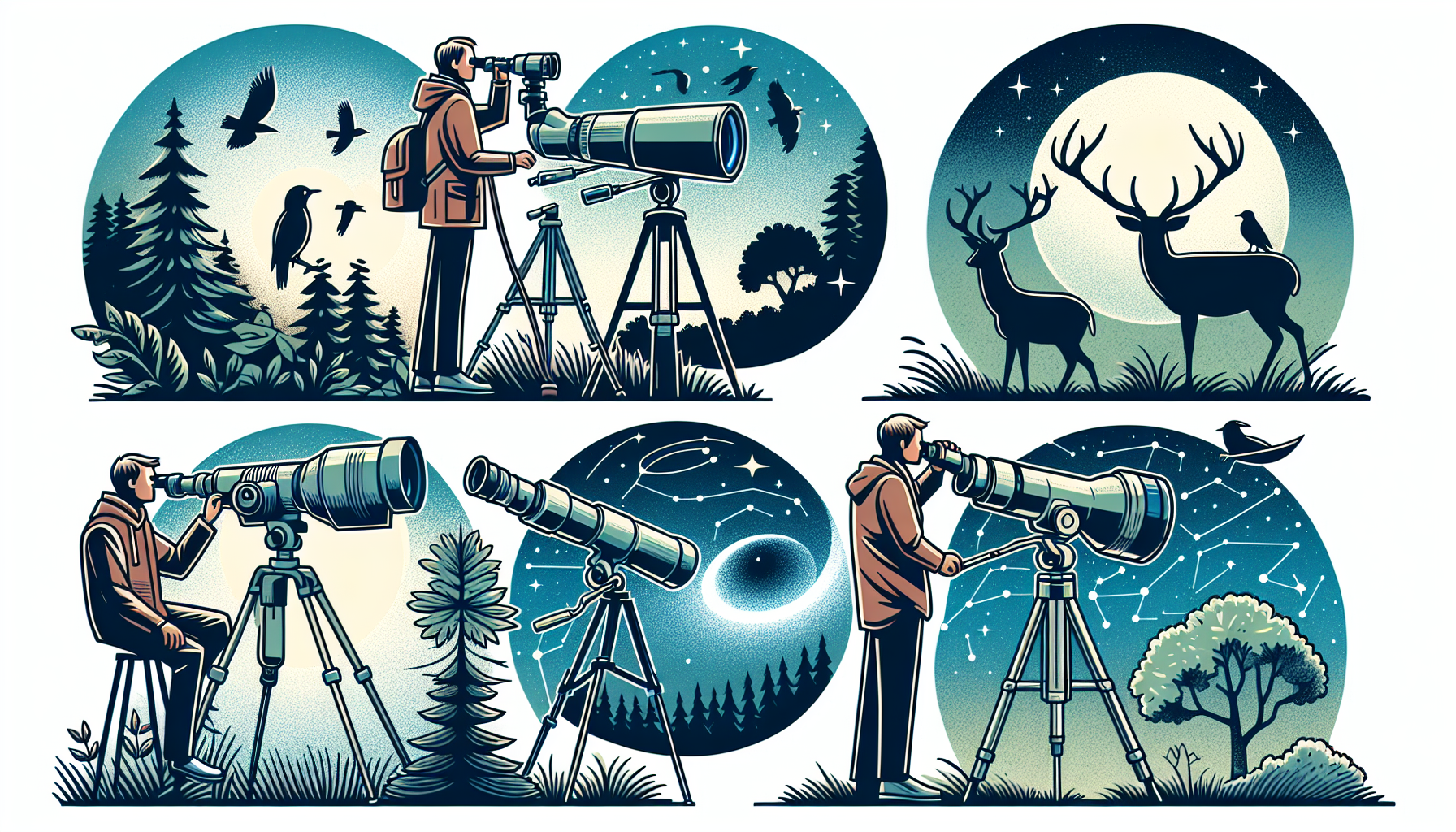Spotting scopes are essential tools for birdwatchers, hunters, and outdoor enthusiasts alike, allowing for a closer and more detailed view of distant objects. With various types available in the market, it can be overwhelming to choose the right one. This article aims to provide a simple yet informative overview of the different types of spotting scopes, helping you make an informed decision based on your specific needs and preferences. So, whether you’re a nature lover yearning to admire rare bird species or a wildlife aficionado hoping to capture stunning photographs, read on to discover which spotting scope suits you best.
Understanding the Basics of Spotting Scopes
Spotting scopes are a must-have tool for anyone who enjoys observing nature, birdwatching, hunting, or long-distance target shooting. They are a type of telescope specifically designed for terrestrial use, offering higher magnification and clarity than binoculars. Spotting scopes allow you to get a closer look at distant objects, making them ideal for detailed observation and identification.
Definition of Spotting Scopes
Spotting scopes are optical devices that resemble small telescopes but are designed for ground-based observation. They consist of a long, straight or angled tube with a large objective lens at the front and an eyepiece at the back. This design allows for high magnification and excellent light gathering capability. Spotting scopes are typically larger and heavier than binoculars, as they require more light-gathering power and stability.
Uses of Spotting Scopes
Spotting scopes have a wide range of uses across various activities. Nature enthusiasts and birdwatchers often use them to observe wildlife, identify bird species, and appreciate landscapes in detail. Hunters use spotting scopes to spot game animals from a distance, analyze their behavior, and plan their approach. Target shooters rely on spotting scopes to see precisely where their shots are landing at long distances. They are also popular among astronomers for terrestrial viewing and astrophotography.
Components of a Spotting Scope
Spotting scopes consist of several essential components that work together to deliver high-quality images. The main components include:
-
Objective Lens: The larger the objective lens, the more light the spotting scope can gather, resulting in a brighter image. It is typically located at the front end of the scope.
-
Eyepiece: The eyepiece is where you look through the spotting scope. It offers various magnification options and can often be interchanged to achieve different levels of zoom.
-
Focus Knob: The focus knob is used to adjust the focus of the image, ensuring a clear and sharp view of the subject.
-
Body: The body of the spotting scope houses all the internal components and determines the overall design, whether straight or angled.

Types of Spotting Scopes
Spotting scopes come in two main designs: angled and straight. Each design has its advantages and is suited to different types of activities.
Angled Spotting Scopes
Angled spotting scopes feature an eyepiece that is set at an angle to the body of the scope. This design allows for more comfortable viewing, especially when observing objects higher up or when sharing the scope among multiple users.
Features of Angled Spotting Scopes
Angled spotting scopes provide several advantages. Firstly, they offer better versatility, as the eyepiece can be adjusted to different angles, making it easier to view objects when looking up or when the spotting scope is mounted on a tripod. Additionally, angled scopes provide more options for comfortable positioning, especially when observing birds in trees or mountainsides.
Ideal Usage of Angled Spotting Scopes
Angled spotting scopes are particularly useful when the subjects being observed are at various heights or when multiple users of differing heights need to share the scope. They are an excellent choice for birdwatchers who frequently track birds in tree canopies or for nature enthusiasts who wish to observe wildlife from various angles.
Pros and Cons of Angled Spotting Scopes
The advantages of angled spotting scopes include their versatility, ease of use when observing objects at different heights, and the ability to share the scope comfortably among users. However, one potential drawback is that they may require more time to get used to due to the angled eyepiece. Additionally, they may not be as suitable for individuals with neck or back problems, as they require more bending of the neck to view through the eyepiece.
Straight Spotting Scopes
Straight spotting scopes have a straight body design, with the eyepiece aligned directly with the objective lens. This design offers a more traditional viewing experience and is often preferred by those who are accustomed to using telescopes or binoculars.
Features of Straight Spotting Scopes
Straight spotting scopes provide a straightforward and intuitive viewing experience. The eyepiece is aligned with the objective lens, resulting in a more natural viewing posture and reduced strain on the neck. This design also makes it easier to quickly locate the subject without the need to angle the scope.
Ideal Usage of Straight Spotting Scopes
Straight spotting scopes are well-suited for activities that involve quick target acquisition, such as target shooting or hunting. They are also preferred by those who are already familiar with the traditional telescope or binocular viewing experience. Furthermore, they are an excellent choice when the scope needs to be mounted on a tripod, as the straight body design provides better stability.
Pros and Cons of Straight Spotting Scopes
The advantages of straight spotting scopes lie in their simplicity, ease of use, and faster target acquisition. They are well-suited for those who prefer a more traditional viewing experience and are frequently used in target shooting competitions. However, one potential disadvantage is that they may be less comfortable for prolonged viewing sessions, as the straight body design requires a more upright posture, which can put strain on the neck and back.
Understanding Magnification in Spotting Scopes
One of the key features of spotting scopes is their magnification capability. Magnification refers to the level of enlargement the scope provides, allowing you to see distant objects as if they were closer. Understanding the concept of magnification is essential in selecting the right spotting scope for your needs.
Importance of Magnification
Magnification plays a crucial role in observing fine details and identifying distant objects. It allows you to see more clearly and analyze subjects with greater precision. However, it’s important to note that higher magnification does not always equate to a better viewing experience. Factors such as atmospheric conditions, stability, and the quality of the optics also affect image quality.
Optimum Magnification Range
Choosing the right magnification for your spotting scope depends on your specific needs and the activities you plan to engage in. For general wildlife observation, a spotting scope with a magnification range of 20x to 60x is commonly recommended. Higher magnification ranges, such as 60x to 80x, are better suited for detailed bird identification or long-range target shooting. It’s also important to consider the stability of the image at higher magnifications, as image shake may become more noticeable.
Impact on Image Quality
While higher magnification can bring distant objects closer, it can also diminish the overall image quality. Vibrations, atmospheric conditions, and lower optical quality can result in a loss of clarity and detail. Therefore, it is important to strike a balance between magnification and image quality based on your specific needs.

Spotting Scopes with Varied Zoom
Another important aspect to consider when choosing a spotting scope is the zoom capability. Some spotting scopes offer fixed zoom, while others provide variable zoom. Understanding the difference between the two can help you select the right spotting scope for your intended use.
Definition of Zoom in Spotting Scopes
Zoom refers to the ability of a spotting scope to adjust the magnification level within a given range. It allows you to seamlessly transition from a lower magnification to a higher magnification, providing flexibility and versatility in observing different objects or distances.
Fixed Zoom Spotting Scopes
Fixed zoom spotting scopes have a predetermined and fixed magnification range. They offer a specific level of magnification and cannot be adjusted beyond that range. While fixed zoom scopes lack the flexibility of adjusting magnification, they often provide better image quality and are more reliable due to their simpler internal mechanisms.
Variable Zoom Spotting Scopes
Variable zoom spotting scopes, as the name suggests, allow for adjustable magnification within a given range. They offer the versatility of changing magnification levels on the go, allowing you to quickly adapt to different situations or observe objects at various distances. Variable zoom spotting scopes are popular among nature enthusiasts and birdwatchers who require the flexibility to adjust magnification based on the behavior and distance of the subject.
Spotting Scope Lens Coating
Lens coating is a critical factor in determining the optical performance of a spotting scope. It plays a significant role in enhancing light transmission, reducing glare, and improving image quality. Understanding the purpose of lens coating and the different types available can help you make an informed decision when choosing a spotting scope.
Purpose of Lens Coating
Lens coating serves several important functions. First and foremost, it helps to enhance light transmission by reducing the amount of light lost due to reflections inside the scope. This results in brighter and clearer images, particularly in low-light conditions. Lens coating also minimizes glare, which can occur when light reflects off the lens surfaces, and it helps protect the lenses from scratches and other damages.
Types of Lens Coatings
There are different types of lens coatings used in spotting scopes, each offering distinct advantages:
-
Coated: These lenses have a single layer of anti-reflective coating on at least one surface, reducing reflections and increasing light transmission.
-
Fully Coated: Lenses labeled as fully coated have anti-reflective coatings on all air-to-glass surfaces, maximizing light transmission and minimizing glare.
-
Multi-Coated: Multi-coated lenses feature multiple layers of anti-reflective coatings on various surfaces. This further improves light transmission and reduces reflections.
-
Fully Multi-Coated: Considered the highest standard, fully multi-coated lenses have multiple layers of anti-reflective coatings on all air-to-glass surfaces. They provide maximum light transmission, exceptional image clarity, and minimal glare.
Effect on Image Quality
The quality of lens coating directly affects the image quality produced by a spotting scope. Scopes with higher-quality coatings, such as fully multi-coated lenses, generally provide better image brightness, contrast, and clarity. These coatings minimize light loss and maximize light transmission, resulting in sharper images with accurate color rendition. When selecting a spotting scope, it is advisable to opt for a model with higher-quality lens coatings, as they significantly enhance the overall viewing experience.

Considerations when Choosing a Spotting Scope
Selecting the right spotting scope requires considering various factors to ensure it meets your specific needs and preferences. Here are some key considerations to keep in mind:
User Needs and Usage
Before choosing a spotting scope, consider how and where you intend to use it. Different activities may require different features. For example, if you are primarily interested in birdwatching, you may prioritize a wider field of view and lower magnification. On the other hand, if target shooting is your main focus, higher magnification and image clarity may be of greater importance.
Budget and Pricing
Spotting scopes come at various price points, ranging from budget-friendly options to high-end models. It is important to establish a budget and determine how much you are willing to invest in a spotting scope. Keep in mind that higher-quality scopes with advanced features often come at a higher cost. However, consider your specific needs and prioritize features accordingly to make an informed decision.
Brand & Quality
When it comes to spotting scopes, opting for a reputable brand known for producing high-quality optics is recommended. Established brands often offer a wide range of models to choose from, ensuring that you can find a spotting scope suitable for your needs. Additionally, renowned brands usually provide reliable warranties and customer support, giving you peace of mind with your purchase.
Spotting Scope Accessories
To enhance your experience with a spotting scope, various accessories are available that can improve functionality, convenience, and protection. Here are a few commonly used spotting scope accessories:
Scope Mounts and Tripods
A steady and stable platform is essential when using a spotting scope for prolonged periods. Scope mounts and tripods provide the necessary support, keeping the scope steady and minimizing image shake. They allow for easy adjustment and positioning of the scope, providing maximum comfort during extended observation sessions.
Lens Cleaning Kits
Spotting scopes often require regular cleaning to maintain optimal performance. Lens cleaning kits designed specifically for optics help remove dust, dirt, and smudges without damaging the delicate lens coatings. These kits typically include soft brushes, lens cleaning solutions, microfiber cloths, and air blowers to ensure you can keep your spotting scope clean and clear.
Carry Cases and Storage
Protecting your spotting scope during transport and storage is essential to prolong its lifespan. Carry cases designed for spotting scopes provide a safe and convenient way to transport your scope while offering protection against impacts, dust, and moisture. They also usually include compartments to store accessories, making it easier to keep everything organized and readily available.
Concluding Remarks on Spotting Scopes
Understanding the various features and aspects of spotting scopes is vital in selecting the right one for your needs. Whether you opt for an angled or straight design, consider the desired magnification and zoom capability, the quality of lens coating, and the accessories that can enhance your experience. By taking these factors into account and considering your specific needs and budget, you can find a spotting scope that will provide you with years of enjoyable and detailed observation. So get ready to explore the world around you and uncover its hidden wonders with the help of a spotting scope tailored to your requirements and preferences. Happy spotting!



